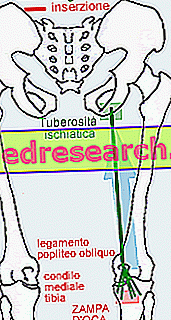Generality
The rhinophyma is a disease of the skin of the nose, which occurs secondarily to a skin condition known as rosacea (or acne rosacea).

The precise causes of rhinophyma are unknown. The only certain data on this is that the condition in question characterizes the cases of rosacea at a serious or untreated stage.
The diagnosis of rhinophyma is very simple and is generally based on a quick physical examination and medical history.
The treatment of rhinophyma depends on the stage of progress of the latter: in the presence of a renofima at the beginning, the doctors opt for a drug therapy; however, in the presence of a rhinophyma at an advanced stage, they can only resort to surgery.
What is rhinophyma?
The rhinophyma is a skin disease, which occurs following advanced or untreated rosacea and which causes a characteristic swelling and redness of the nose . The rhinophyma, therefore, is a disease of the nasal skin, secondary to a condition of severe and / or poorly treated rosacea.
SYNONYMS
The rhinophyma is also known as a " potato nose ".
The term "potato nose" is somewhat ambiguous, as it is also used to define those noses which, due to their natural somatic characteristics, possess a rounded tip and marked wing cartilages.
Epidemiology
The rhinophyma is a very rare condition, which is observed mainly in individuals with untreated rosacea or advanced rosacea.
Rhinophyma is more common in the male population.
Causes
The rhinophyma is certainly linked to the presence of rosacea; however, the precise pathological mechanisms with which the latter causes rhinophyma have always been a mystery.
SOME HYPOTHESIS
Several doctors and pathologists have tried to study the causes of rhinophyma, developing some theories about it.
Among the various hypotheses formulated regarding the possible factors triggering the rhinophyma, two are reported:
- The hypothesis according to which the rhinophyma would depend on a dilation of the blood vessels, which has the effect of thickening the skin of the nose,
is
- The hypothesis according to which the rhinophyma derives from an instability of the nasal blood vessels, which determines, first, the anomalous loss of liquid in the surrounding tissues and, secondly, an inflammatory state and the formation of scar tissue.
ROSACEA: WHAT IS IT? A BRIEF REVIEW
Rosacea (or acne rosacea ) is a chronic inflammatory disease of the skin, which affects the face, especially its central part.
Despite numerous studies on the subject, the precise causes of rosacea are still in doubt. According to some of the most reliable theories, to cause the condition in question would be a fragility of the capillaries of the face, dependent on environmental factors and genetic factors. In other words, a mix of triggers would contribute to the appearance of rosacea.
Rosacea most often affects people with fair skin and aged between 30 and 50 years. Several factors can aggravate it, including: emotional stress, cold or hot weather, the ingestion of spicy or spicy foods, intense physical exertion, cosmetics, wind, alcohol consumption and cigarette smoking.
The typical symptoms and signs of rosacea consist of: redness of the face, appearance of lesions or papules, telangiectasia, irritation and burning sensation in the eyes, and thickening of the skin.
Unfortunately, at the present time, there are no specific treatments for rosacea, but only non-specific treatments for the alleviation of symptoms (symptomatic therapy).

RINOFIMA AND ROSACEA
The rhinophyma distinguishes a particular type of rosacea, known as fimatosa rosacea .
In addition to changing the appearance of the nose, fimatosa rosacea can also alter the aesthetics of: chin ( gnatofima ), ears ( otofima ), eyelids ( blepharofima ) and / or forehead ( metofima )
DEPENDS ON ALCOHOLISM?
In the past, it was widely believed that rhinophyma depended on alcohol abuse ( alcoholism ).
Today, after extensive and more than reliable studies, it is known that rhinophyma does not depend in any way on the abuse of alcoholic substances.
RISK FACTORS
They are risk factors for rhinophyma:
- The male sex;
- Age between 30 and 50 years;
- The fair complexion;
- Light colored hair;
- Blue or green eyes;
- A family history of rosacea.
Symptoms, signs and complications
Due to rhinophyma, the nose is subject to drastic changes:
- It becomes bulbous and, in general, assumes an irregular shape;
- His skin suffers an evident thickening;
- Its surface becomes rough;
- It assumes a red-violet color, due to telangiectasia and / or venulectasis;
- The pores of the skin become prominent and an unusual and large oily secretion emerges from them;
- The sebaceous glands that cover the cartilaginous portions dilate (hypertrophy of the sebaceous glands).
In general, the rhinophyma affects the tip of the nose and the so-called nasal wings, ie the portions of the lateral nose at the tip.

Figure: through this image, readers can appreciate the external anatomy of the nose and, in particular, the site of the nasal tip and nasal wings.
DEGREES OF RINOFIMA SEVERITY
Doctors rate the severity of rhinophyma in three degrees:
- grade 1, which corresponds to the less severe rhinophyma,
- the grade 2, which is equivalent to the rhinophyma of intermediate severity
- grade 3, which corresponds to the most serious rhinophyma of all.
Grade 1 includes all cases of rhinophyma characterized by the excessive opening of the pores of the skin and by the absence of skin thickening; Grade 2 includes all cases of rhinophyma characterized by the excessive opening of the pores of the skin and a moderate thickening of the nasal skin; finally, all cases of rhinophyma are included in grade 3 in which the over-opening of the skin pores is associated with skin thickening and hypertrophy of the sebaceous glands.
| Summary table of degrees of severity of rhinophyma | |
| Degree and severity | Features |
| Grade 1, the least serious |
|
| Grade 2, intermediate gravity |
|
| Grade 3, the most serious |
|
COMPLICATIONS
In the absence of treatments, the changes that the rhinophyma causes to the damage to the nose tend to worsen.
The rhinophyma at an advanced stage disfigures the face of an individual in a marked and evident way. This can have psychological repercussions (eg anxiety, etc.), linked to an aesthetic discomfort.
The rhinophyma is not a prelude to skin neoplasms.
Diagnosis
Being responsible for characteristic nasal changes, rhinophyma is a condition that doctors diagnose very easily, through a simple observation of the nose ( physical examination ) and a medical history .
In the remote case where there are doubts about the presence or absence of rhinophyma, the ideal diagnostic test to definitively clarify the situation is the biopsy of a portion of nasal skin .
Therapy
The treatment of rhinophyma depends on the stage of progress of the latter. In fact, if the rhinophyma is in its infancy, a pharmacological treatment may suffice; while, if the rhinophyma is at an advanced-severe stage, the use of surgical treatments is indispensable.
PHARMACOLOGICAL TREATMENT
Pharmacological treatment for rhinophyma, rather than treating the present condition, slows down the progress of symptoms; it includes:
- Oral antibiotics (eg: tetracycline, erythromycin or minocycline), to reduce any inflammation and redness;
- Topical medicines (eg: metronidazole, tretinoin or azelaic acid), to reduce nasal swelling;
- Particular capsules for oral use (eg: oral isotretinoin), to prevent the production of mucous secretions, by the nasal sebaceous glands.
Please note that the aforementioned pharmacological preparations are also indicated for the treatment of rosacea.
SURGICAL TREATMENT
The purpose of surgical treatment is to give the nose a normal or almost normal appearance.
Through surgery, doctors can:
- Eliminate the most obvious nasal deformations;
- Remove excess skin portions;
- Minimize telangiectasia and venulectasis;
- Improve the aesthetics of the nose.
To succeed in the aforementioned aims, there are various surgical techniques, including:
- Traditional surgery, which involves the use of scalpels etc;
- Dermabrasion, which consists in eliminating, through a special instrument, the most superficial layers of the skin (in this case the nasal skin);
- Electrosurgery, which involves the use of electric current to destroy unwanted nasal tissue;
- Cryosurgery, which relies on low temperatures to eliminate deformed nasal tissue and to be removed;
- YAG laser therapy .
Prognosis
Currently available rhinophyma treatments guarantee good results, so the prognosis tends to be favorable.
Clearly, as with many other morbid conditions, the sooner diagnosis and therapy take place, the greater the chance of remedying nasal disfigurements in people with rhinophyma.
RELAPSE
Unfortunately, even when the treatments have been successful, there is the possibility that the rhinophyma appears again (relapse).



